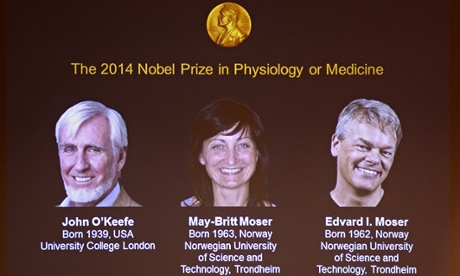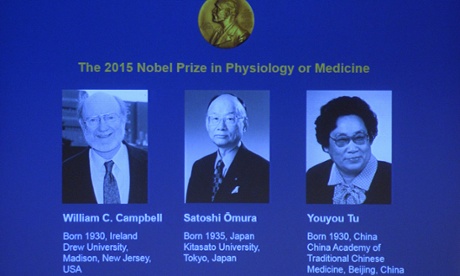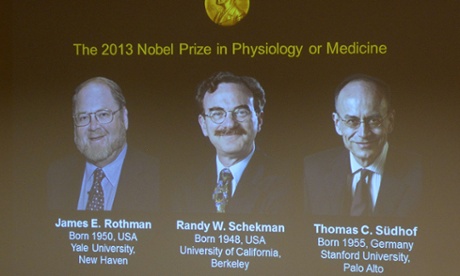We’ve had a late reaction from Hugo Spiers, who as the head of the Spatial Cognition Group at University College London is perfectly placed to explain the research behind this year’s prize. His morning schedule was disrupted by a fire alarm at UCL, but he found time to send us this neat summary:
All three scientists awarded the prize have dramatically changed how we understand the brain’s navigation and memory systems. John O’Keefe made a remarkable discovery in 1971 when he found ‘place cells’ in a brain region called the hippocampus, which provide an organised map of space in their activity patterns.
O’Keefe speculated that place cells would need information akin to latitude and longitude in order to map space. Where this signal was located remained mysterious until 2005 when May-Britt and Edvard Moser discovered ‘grid cells’ in a brain region known as the medial entorhinal cortex. These cells show hexagonal patterns of activity stretching over the space traversed, similar to the lines that mark out distances on a globe.
Grid cells and place cells offer one of the few bridges neuroscientists have linking the cellular level to the cognitive level, as they help explain how individual brain cells help us navigate, remember the past and imagine the future. The IgNobel prizewinning discovery that the hippocampus of London taxi drivers grows larger with experience would have likely been missed without such fundamental discoveries.
Updated
That’s it from the Guardian science desk for today. We’ll be back tomorrow liveblogging the announcement of the Nobel Prize for Physics, which is expected at around 10.45am UK time.
Prof John Aggleton, president-elect of the British Neuroscience Association, points out that O’Keefe was a founder member of the association, which celebrates its 50th anniversary next year:
Prof O’Keefe’s Nobel Prize is indeed a richly deserved honour for him that all UK neuroscientists will applaud.
Updated
Prof John Stein, Emeritus Professor of Physiology, University of Oxford, reminds us how brilliant discoveries are often ridiculed when they’re first revealed to the world:
I remember how great was the scoffing in the early 1970s when John first described ‘place cells’ … ‘Bound to be an artifact’, ‘He clearly underestimates rats’ sense of smell’ were typical reactions. Now, like so many ideas that were at first highly controversial, people say ‘Well that’s obvious’!
Updated
Jeremy Farrar, director of the Wellcome Trust, has congratulated O’Keefe on behalf of the trust:
I am absolutely thrilled that John O’Keefe, our close colleague at the Wellcome Trust, has won the Nobel Prize. John’s work, which the Trust is proud to have supported for over 10 years, has transformed our understanding of how the brain represents space. He is a world leader who has inspired a generation of neuroscientists, and whose work as founding Director of the Sainsbury Wellcome Centre will further enhance our knowledge of neural circuits and how we behave.
The winners of the Nobel prize in physiology or medicine 2014
As the Nobel citation says:
for their discoveries of cells that constitute a positioning system in the brain
- John O’Keefe, 75, of University College London
- May-Britt Moser, 51, of the Norwegian University of Science and Technology in Trondheim
- Edvard Moser, 52, also of the Norwegian University of Science and Technology in Trondheim
May-Britt and Edvard met as postdocs in John O’Keefe’s lab. They are the fifth married couple to win a Nobel prize.
Updated
Full marks to the team at Nature for this timely piece on May-Britt and Edvard Moser. They could make money with that sort of foresight.
@james_randerson @NatureNews No. Really was a lucky coincidence. If we had prior knowledge we'd have done O'Keefe too!
— Richard Van Noorden (@Richvn) October 6, 2014
My colleagues across the newsroom have been crunching the Nobel data. Here they present the Nobel prizes in numbers (click the link or scroll down to the earliest post on this liveblog). Britain has fared ok, he writes non-smugly.
Updated
John Williams at the Wellcome Trust shares his thoughts on the prize:
John [O’Keefe] above all else is a renaissance man. He looks widely and broadly across neuroscience and he’s a keen an enthusiastic basketball player. From probing the functions of fundamental brain circuits to shooting hoops - with Obama, I gather - what more can one ask for from a leading academic?
How did Nature pull off the feat of having a feature-length article about the lifetime work of May-Britt Moser and Edvard Moser ready to publish before the Nobel Committee had announced the winners?
Nobel selfie!
Selfie med en #nobelprisvinner #nobelprize2014 @MayBrittMoser pic.twitter.com/F26Wi85SCA
— Hege Tunstad (@HegeTunstad) October 6, 2014
How the brain maps space … and finds our place
Here’s Edvard I Moser describing how the brain creates a map of the space around us:
Updated
Like longitude and latitude … without the map
An interview with May-Britt Moser and Edvard I Moser at the Norwegian University of Science and Technology:
Updated
More from the Nobel committee on that “inner GPS system” that helps us navigate our environment:
The sense of place and the ability to navigate are fundamental to our existence. The sense of place gives a perception of position in the environment. During navigation, it is interlinked with a sense of distance that is based on motion and knowledge of previous positions.
Questions about place and navigation have engaged philosophers and scientists for a long time. More than 200 years ago, the German philosopher Immanuel Kant argued that some mental abilities exist as a priori knowledge, independent of experience. He considered the concept of space as an inbuilt principle of the mind, one through which the world is and must be perceived. With the advent of behavioural psychology in the mid-20th century, these questions could be addressed experimentally. When Edward Tolman examined rats moving through labyrinths, he found that they could learn how to navigate, and proposed that a “cognitive map” formed in the brain allowed them to find their way. But questions still lingered – how would such a map be represented in the brain?
Updated
John O’Keefe trivia: He’s an enthusiastic basketball player and still dreams of playing in the NBA. At weekends he can be found wandering about on the hills or beaches of southern England discussing philosophy with his wife, Eileen. She’s a professor of public health. The two met at philosophy class at City College of New York.
Congrats from the Wellcome Trust
Fantastic news - John O'Keefe of Sainsbury Wellcome Centre & @uclnews wins @NobelPrize. Congratulations!
— Wellcome Trust (@wellcometrust) October 6, 2014
May-Britt Moser becomes the 11th woman to win the medicine prize since the award began in 1901.
What did they do?
The Nobel committee likens the winners’ work to an “internal GPS system”. From the notes they have produced on the science:
How do we know where we are? How can we find the way from one place to another? And how can we store this information in such a way that we can immediately find the way the next time we trace the same path? This year´s Nobel Laureates have discovered a positioning system, an “inner GPS” in the brain that makes it possible to orient ourselves in space, demonstrating a cellular basis for higher cognitive function.
This is how the contributions from the three winners break down:
In 1971, John O’Keefe discovered the first component of this positioning system. He found that a type of nerve cell in an area of the brain called the hippocampus that was always activated when a rat was at a certain place in a room. Other nerve cells were activated when the rat was at other places. O’Keefe concluded that these “place cells” formed a map of the room.
More than three decades later, in 2005, May‐Britt and Edvard Moser discovered another key component of the brain’s positioning system. They identified another type of nerve cell, which they called “grid cells”, that generate a co-ordinate system and allow for precise positioning and pathfinding. Their subsequent research showed how place and grid cells make it possible to determine position and to navigate.
The discoveries of John O’Keefe, May‐Britt Moser and Edvard Moser have solved a problem that has occupied philosophers and scientists for centuries – how does the brain create a map of the space surrounding us and how can we navigate our way through a complex environment?
Updated
More on the winners
One half of the prize goes to John O’Keefe. The other half is split by May-Britt Moser and Edvard I Moser.
John O’Keefe is the director of the Sainsbury Wellcome Centre in Neural Circuits and Behaviour at University College London. He was born in 1939 and holds both US and British citizenship.
May‐Britt Moser is a Norwegian citizen. She worked at UCL in the past but is now director of the Centre for Neural Computation in Trondheim.
Edvard I Moser is also Norwegian. He was a postdoc with his wife May‐Britt Moser, first at the University of Edinburgh and later a visiting scientist in John O’Keefe’s laboratory in London. In 1996 they moved to the Norwegian University of Science and Technology in Trondheim, where Edvard Moser became professor in 1998. He is
currently director of the Kavli Institute for Systems Neuroscience in Trondheim.
Updated
The winners of the 2014 Nobel prize in physiology or medicine
And the winners are...
John O’Keefe
May-Britt Moser
and Edvard Moser
The last two are married!
For work on cells that constitute a positioning system in the brain.
Updated
Here they come. Time to get ready to shout “Who?”
We’re expecting the Nobel committee representatives to take their seats any moment now. The journalists are all ready and waiting.
Twitter is alive with speculation …
It's only a matter of time before Dieseroth and Boyden win for optogenetics. Will it be today? #nobelprize2014
— Dr Adam Rutherford (@AdamRutherford) October 6, 2014
The winners by field. I’m rooting for the virologists
If you sort the Medicine Laureates by field, genetics end up in the first place: pic.twitter.com/sKSrm3Mlda
— The Nobel Prize (@NobelPrize) October 6, 2014
Runners and riders
Who is in the running to get this year’s prize?
Thomson Reuters, a science information business, mines scientific study citations to predict a handful of winners each year. They are tipping James E Darnell Jr at Rockefeller University, Robert G Roeder and Robert Tjian at the University of California, Berkeley, for work on eukaryotic transcription and gene regulation. Other tips from them are David Julius at the University of California, San Francisco, for elucidating the molecular mechanisms of pain sensation, and another trio: Charles Lee at the Jackson Laboratory for Genomic Medicine in Farmington, Connecticut, Stephen W Scherer at the University of Toronto, Canada, and Michael Wigler at Cold Spring Harbor, New York, for work on large-scale copy number variation and its association with specific diseases.
Those predictions are in line with history: most winners are middle-aged men and many are working in the US when they receive the award. But I’m going to throw a few other names into the pot: the Austrian electrical engineer Ingeborg Hochmair for cochlear implants, and Kazutoshi Mori of Kyoto University, Japan, and Peter Walter of the University of California, San Francisco, for their work on the unfolded protein response.
Updated
All set to reveal the winners …
Within hopefully less than 30 min. prof Göran Hansson will enter the podium and announce the first #nobelprize2014. pic.twitter.com/P6sRUNgbRM
— The Nobel Prize (@NobelPrize) October 6, 2014
The 2013 winners
Last year, James E Rothman at Yale University, Randy W Schekman at the University of California, Berkeley, and Thomas C Südhof at Stanford University won the Nobel Prize in Physiology or Medicine for solving the mystery of how the cell organises its transport system.
Here’s how the Nobel Assembly described their contribution:
Each cell is a factory that produces and exports molecules. For instance, insulin is manufactured and released into the blood and signalling molecules called neurotransmitters are sent from one nerve cell to another. These molecules are transported around the cell in small packages called vesicles. The three Nobel laureates have discovered the molecular principles that govern how this cargo is delivered to the right place at the right time in the cell.
The last time a UK scientist won the prize was in 2012 when Sir John Gurdon shared the honours with Shinya Yamanaka for their discovery that mature cells can be reprogramed to grow into other cell types. Gurdon was famously written off by his Eton schoolmaster who wrote a report declaring the 15-year-old’s hopes to become a scientist as “quite ridiculous”. Gurdon keeps the report on the wall at his lab.
Updated
The science world awaits …
It’s Nobel prize time again!
Over the next few days, we will learn who has won this year’s coveted Nobel prizes for science. For the chosen ones life will never be the same again. There’s the kudos, the unrelenting requests to deliver guest lectures, and let’s not forget the cash: 8m Swedish kronor (£690,000). You could buy a two-bed flat in London for that.
The award-giving starts this morning with the Nobel Prize in Physiology or Medicine. The winner, or winners, will be announced from Stockholm at or around 10.30am UK time. On Tuesday it’s the physics prize. On Wednesday, it’s chemistry (though in recent years, the chemistry prize has become more of a biosciences prize).
But back to today. The prize in physiology or medicine has been given 204 times since 1901. Previous winners have included Sir Alexander Fleming for penicillin (1945); Peter Medawar for work on immunological intolerance (1960); Francis Crick, James Watson and Maurice Wilkins for the structure of DNA (1962); and Sir Paul Nurse, the president of the Royal Society, for work on regulators of the cell cycle (2001). Only 10 women have been awarded the physiology or medicine prize.
Some trivia: in 1949, Egaz Moniz won the prize for inventing the lobotomy. On the plus side, despite 32 nominations, Sigmund Freud never received the honour. He was later nominated by a friend for the Nobel Prize in Literature – perhaps the rejection had something to do with it.
Updated











